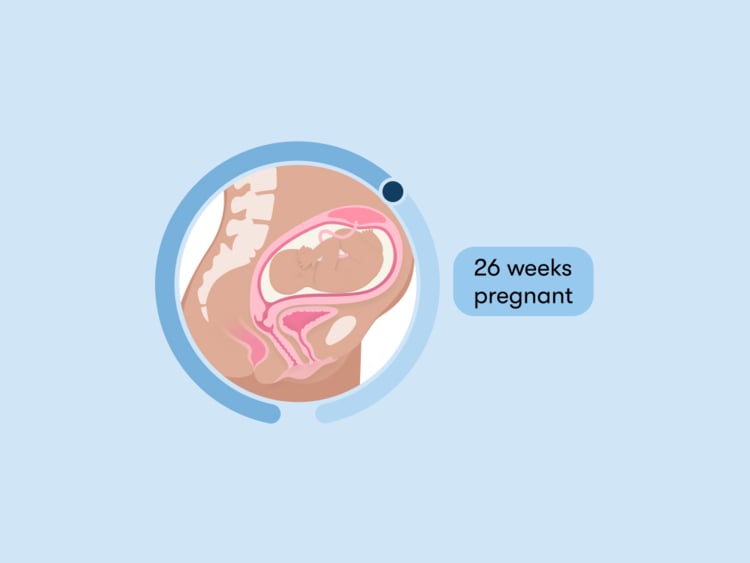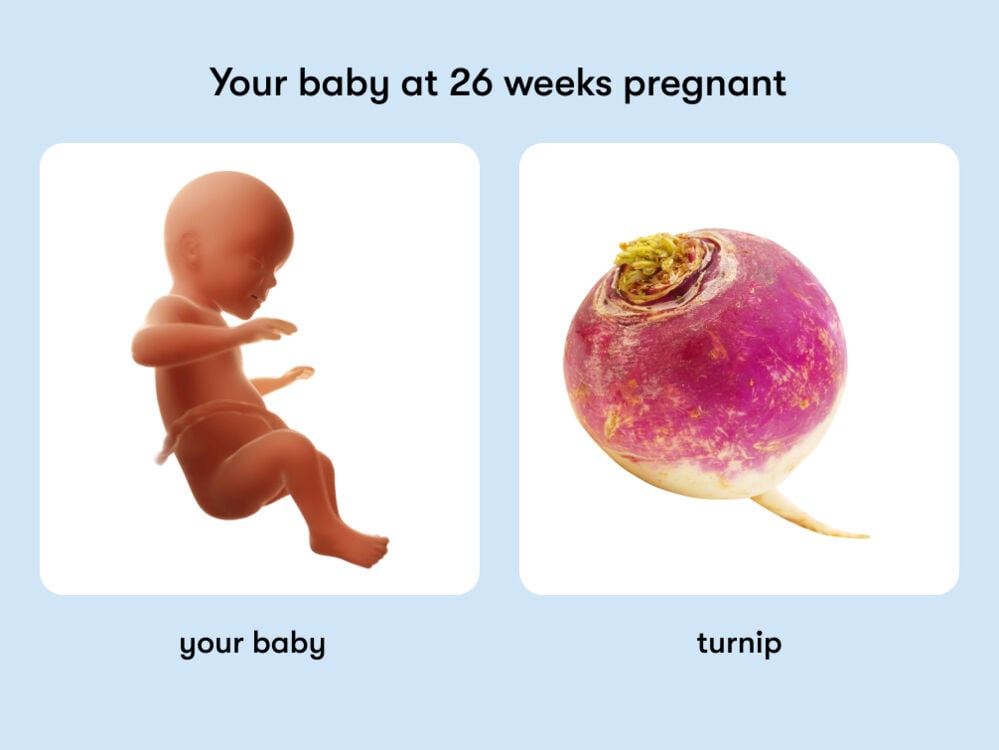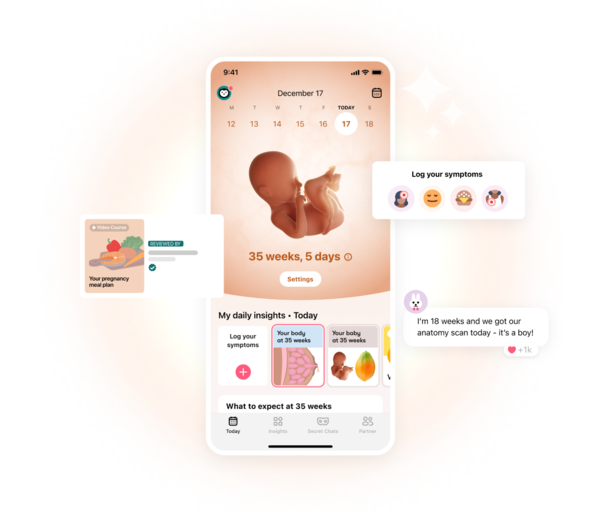From leg and foot cramps to nesting, here’s the lowdown on being 26 weeks pregnant.
-
Tracking cycle
-
Getting pregnant
-
Pregnancy
-
Help Center
-
Flo for Partners
-
Anonymous Mode
-
Flo app reviews
-
Flo Premium New
-
Secret Chats New
-
Symptom Checker New
-
Your cycle
-
Health 360°
-
Getting pregnant
-
Pregnancy
-
Being a mom
-
LGBTQ+
-
Quizzes
-
Ovulation calculator
-
hCG calculator
-
Pregnancy test calculator
-
Menstrual cycle calculator
-
Period calculator
-
Implantation calculator
-
Pregnancy weeks to months calculator
-
Pregnancy due date calculator
-
IVF and FET due date calculator
-
Due date calculator by ultrasound
-
Medical Affairs
-
Science & Research
-
Pass It On Project New
-
Privacy Portal
-
Press Center
-
Flo Accuracy
-
Careers
-
Contact Us
26 weeks pregnant: Your guide to this week of your second trimester


Every piece of content at Flo Health adheres to the highest editorial standards for language, style, and medical accuracy. To learn what we do to deliver the best health and lifestyle insights to you, check out our content review principles.
At 26 weeks pregnant, you’re probably very curious about what’s going on inside your growing baby bump. Read on to find out why it’s an important week for your baby’s eyes and lungs, plus tips from a Flo expert on how you might be feeling as your pregnancy hormones change and your baby continues to grow.
Your baby at 26 weeks pregnant
Your baby’s lungs have formed
This week, your baby’s lungs have started producing the substance that will later allow the air sacs in the lungs to inflate. Called surfactant, this substance will prevent the air sacs from collapsing and sticking together when the lungs deflate.
By 36 weeks of pregnancy, your baby will be fully ready to take their first breath after they are born. So while your baby’s little lungs have still got some developing to do, it can be lovely to think that they are one step closer to being able to take their first breath after birth.
Your baby can open their eyes
This week, your baby is also able to open their eyelids, and soon they will learn how to blink. It’s a big week for their eyes, as they are also starting to produce melanin — the substance that gives their eyes and skin their color. You may have heard that all babies are born with blue eyes, but this is a myth.
However, it is true that a baby’s eye color can keep changing for a while after birth. While their permanent color sometimes doesn’t settle until they reach adulthood, this will usually happen by the time they’re three years old. The color of your baby’s eyes is based on their parents’ genetics, so there’s a good chance they’ll end up with the same color eyes as you or your partner!
How big is a baby at 26 weeks?
Length (crown to heel): 35.1 cm or 13.8 in.
Weight: 913 g or 2 lb.
Size: Equivalent to a turnip
All measurements are approximate and vary within the normal range.

Your body at 26 weeks pregnant
Leg or foot cramps
Frustrating but true: leg or foot cramps are a common symptom of pregnancy at this stage. Cramps can feel like a sudden pain in your calf muscles or feet, and they generally happen at night — thanks, Mother Nature! If you’re experiencing these cramps at 26 weeks pregnant, the following exercises can help to ease the pain:
- Stretch your toes upward toward your ankle as hard as you can
- Rub the muscle where it hurts as hard as you can
- Rotate each foot eight times one way, then eight times the other way
- Bend and stretch your foot vigorously up and down 30 times
Noting your symptoms in an app like Flo can also help you keep track of how they’re affecting you, as well as the remedies that help.
Finally, if you’re not experiencing cramping at 26 weeks pregnant, then rest assured that doesn’t mean anything is wrong. While it’s a common symptom, not everyone gets it. The exact cause of leg and foot cramps in pregnancy isn’t clear, but it may be possible to prevent them with things like regular stretching, gentle exercise, and drinking plenty of water.
Nesting
Have you found yourself organizing your fridge, spending hours looking at nursery inspo on Pinterest, or arranging your baby’s outfits by color this week? It could be the nesting instinct kicking in. This could be due to a sudden spurt of energy leading to an urge to organize your home in time for your baby’s arrival.
“Most people get a surge of energy at this point after feeling so crummy in the first trimester,” says Dr. Cynthia DeTata, clinical assistant professor of obstetrics and gynecology at Lucile Packard Children’s Hospital, California, US.
Dr. DeTata adds that many pregnant women enjoy the second-trimester energy boost because they feel more like their usual selves. “Many are happy to be able to function more fully at work,” she says, adding that “‘nesting’ is something that many do toward the end of pregnancy.” So it’s normal if you haven’t felt like nesting just yet — you (and your fridge) have likely got all that to look forward to.
Your questions answered
Is 26 weeks considered to be the same as 7 months pregnant?
It’s time for some quick pregnancy math. Right now, you are midway through your seventh month of pregnancy. So that means that 26 weeks pregnant is also seven months pregnant. This month can feel high-action, as your baby might be changing position frequently.
This week, your baby will also start responding to sounds, so it can be a lovely time to deepen the growing bond between you by talking (or even singing!) to them. While they will be able to hear your voice the most clearly, asking others to speak and sing to them will help your baby get to know their voices, too, while feeling safe and secure.
Is my baby fully developed at 26 weeks?
“A baby at 26 weeks is not fully developed,” explains Dr. DeTata. If they haven’t already, then “your doctor will talk about warning signs for preterm labor and will look for physical signs at your return visits,” she adds.
Preterm labor is labor that starts before 37 weeks of pregnancy (a typical pregnancy lasts 40 weeks), but it doesn’t necessarily mean you’ll go on to have a preterm birth. One important sign that you could be going into preterm labor is regular or frequent contractions that are often painless. Other signs and symptoms to look for include mild abdominal cramps (with or without diarrhea) and a constant, low, dull backache. As scary as preterm labor sounds, it’s important to note that it’s quite rare — globally, between 9% and 12% of births are preterm.
Meanwhile, extreme preterm births are when babies are born before the mother is 28 weeks pregnant, and these are very rare. In fact, just two to five in every 1,000 pregnancies are affected by this. It can be reassuring to speak to your doctor if you have any concerns and remember that they will be on the lookout for any signs on your behalf.
How is the baby positioned at 26 weeks?
As we previously explored, your baby may be changing positions frequently, and that will continue this week. “[The baby’s position at 26 weeks pregnant] is variable,” agrees Dr. DeTata.
It’s normal for your baby to move around into different positions. Earlier on in your pregnancy, they had plenty of room to move freely, but their ability to change position will become more limited as they get bigger. Toward the end of your pregnancy, around 32 to 36 weeks, most babies will settle into their final position for birth.
Take a quiz
Find out what you can do with our Health Assistant
26 weeks pregnant checklist
Get some selenium
Stocking up on certain nutrients by eating well is one of the best things you can do in pregnancy to support your body and growing baby.
One of the nutrients that may be particularly beneficial is the mineral selenium, which can help both you and your baby to build up an efficient antioxidant defense. Antioxidants are substances that protect your cells against molecules called free radicals, which may play a role in diseases like cancer or heart disease. Research also suggests selenium plays a role in the development of your baby’s lungs.
You can get more selenium from your diet by eating certain foods, including seafood, lean red meat, and grains grown in soil that is rich in selenium. If you’re interested in boosting your selenium intake through a supplement, it’s recommended that pregnant women take 65 mcg per day. But remember, it’s always best to speak to your health care provider first before taking any new medication or supplement while pregnant.
Address gestational diabetes
Has your doctor spoken to you about gestational diabetes yet? If not, we’ll fill you in quickly: gestational diabetes is a type of diabetes that can develop in pregnancy if your blood sugar levels are too high. If left untreated, the condition can cause problems for you and your baby, which is why gestational diabetes screening is one of the routine tests you should be offered while pregnant. Usually, testing happens between 24 and 28 weeks (or earlier if you have any risk factors), so it’s likely your doctor will be talking to you about it soon if they haven’t already. If you’re having your test in the coming weeks, try not to worry — gestational diabetes is not that common and is highly manageable for those that do have it.
Plan a babymoon
There’s no doubt that growing a baby is hard work. If you’re feeling like you deserve a holiday right now, we hear you! In fact, this week could be the perfect time to plan a babymoon. Like a honeymoon, a babymoon is a celebratory holiday — except instead of celebrating a marriage, you’re commemorating your pregnancy and the final few months before your baby arrives.
Of course, you don’t have to have a partner to have a babymoon. If you’re single at the moment, why not plan a trip with your best friend or family? Spending quality time with your loved ones in this way can help you feel more relaxed as your pregnancy progresses. Go on — you deserve it.
When to consult a doctor at 26 weeks pregnant
You should have regular prenatal appointments with your doctor, which may be around every four weeks throughout your second trimester, depending on your pregnancy needs and where you live. During these visits, your doctor will check your vitals, like your blood pressure and weight, and discuss any concerns you might have.
You don’t need to wait until your appointment if you have any concerns or questions about your pregnancy. However, at 26 weeks pregnant, you should contact your health care provider immediately if you experience:
- Severe cramping
- Vaginal bleeding
- Changes in vaginal discharge
- Fever
- Dizziness or fainting
- Severe vomiting
- Severe headaches or blurry vision
- Intense heartburn
- A decrease in the amount you feel your baby move
- A loss of liquid from your vagina or watery/mucus-like discharge (This could be a sign of premature labor.)
This isn’t an exhaustive list but just some examples of the changes that could happen. Some of these can be a sign of health complications, so it’s essential that you speak to your doctor about the best next step for you. And if you’re ever worried about any other symptoms you experience during pregnancy, don’t hesitate to reach out to your health care provider.
26 weeks pregnant: The takeaway
Knowing that your baby is opening their eyes and getting closer to taking their first breath can make 26 weeks pregnant feel like a magical time. But if other symptoms are getting you down, try not to put pressure on yourself to enjoy being pregnant all the time. Instead, practice self-compassion toward whatever is coming up for you at each stage of this journey.


Hey, I'm Anique
I started using Flo app to track my period and ovulation because we wanted to have a baby.


The Flo app helped me learn about my body and spot ovulation signs during our conception journey.


I vividly
remember the day
that we switched
Flo into
Pregnancy Mode — it was
such a special
moment.
Real stories, real results
Learn how the Flo app became an amazing cheerleader for us on our conception journey.
References
“Week 26.” NHS, www.nhs.uk/start4life/pregnancy/week-by-week/2nd-trimester/week-26/. Accessed 10 July 2023.
Arigliani, Michele, et al. “Nutrition and Lung Growth.” Nutrients, vol. 10, no. 7, July 2018, https://doi.org/10.3390/nu10070919.
“Attachment and Bonding during Pregnancy.” NHS Inform, 25 Jan. 2023, www.nhsinform.scot/ready-steady-baby/pregnancy/relationships-and-wellbeing-in-pregnancy/attachment-and-bonding-during-pregnancy.
“Bleeding during Pregnancy.” The American College of Obstetricians and Gynecologists, May 2021, www.acog.org/womens-health/faqs/bleeding-during-pregnancy.
“Common Health Problems in Pregnancy.” NHS, www.nhs.uk/pregnancy/related-conditions/common-symptoms/common-health-problems/. Accessed 10 July 2023.
“Fetal Development: The 2nd Trimester.” Mayo Clinic, 3 June 2022, www.mayoclinic.org/healthy-lifestyle/pregnancy-week-by-week/in-depth/fetal-development/art-20046151.
“Fetal Development.” Cleveland Clinic, my.clevelandclinic.org/health/articles/7247-fetal-development-stages-of-growth. Accessed 15 June 2023.
Curran, Mark A. “Fetal Development.” Perinatology.com, perinatology.com/Reference/Fetal%20development.htm. Accessed 10 July 2023.
“Fetal Positions for Birth.” Cleveland Clinic, my.clevelandclinic.org/health/articles/9677-fetal-positions-for-birth. Accessed 26 June 2023.
Friel, Lara A. “Fevers during Pregnancy.” MSD Manual Consumer Version, Oct. 2021, www.msdmanuals.com/home/women-s-health-issues/pregnancy-complicated-by-disease/fevers-during-pregnancy.
“Gestational Diabetes.” Cleveland Clinic, my.clevelandclinic.org/health/diseases/9012-gestational-diabetes. Accessed 26 June 2023.
“How COVID-19 Makes Pregnancy Different.” Cleveland Clinic, 10 Aug. 2021, health.clevelandclinic.org/how-covid-19-makes-pregnancy-different/.
“Kick Counts.” Cleveland Clinic, my.clevelandclinic.org/health/articles/23497-kick-counts. Accessed 14 June 2023.
“What Causes Leg Cramps during Pregnancy, and Can They Be Prevented?” Mayo Clinic, 12 Apr. 2023, www.mayoclinic.org/healthy-lifestyle/pregnancy-week-by-week/expert-answers/leg-cramps-during-pregnancy/faq-20057766.
“How to Travel Safely during Pregnancy.” Patient, 10 Apr. 2018, patient.info/news-and-features/how-to-travel-safely-during-pregnancy.
Morgan, Andrei S., et al. “Management and Outcomes of Extreme Preterm Birth.” BMJ, vol. 376, Jan. 2022, www.bmj.com/content/376/bmj-2021-055924#.
“Morning Sickness: Nausea and Vomiting of Pregnancy.” The American College of Obstetricians and Gynecologists, May 2020, www.acog.org/womens-health/faqs/morning-sickness-nausea-and-vomiting-of-pregnancy.
“Nutrition during Pregnancy.” The American College of Obstetricians and Gynecologists, June 2023, www.acog.org/womens-health/faqs/nutrition-during-pregnancy.
Pappas, Athanasios C., et al. “Maternal Selenium and Developmental Programming.” Antioxidants, vol. 8, no. 5, May 2019, doi.org/10.3390/antiox8050145.
“Heartburn during Pregnancy.” Cleveland Clinic, my.clevelandclinic.org/health/diseases/12011-heartburn-during-pregnancy. Accessed 14 June 2023.
“Preterm Labor.” Mayo Clinic, 8 Feb. 2022, www.mayoclinic.org/diseases-conditions/preterm-labor/symptoms-causes/syc-20376842.
“Preterm Labor and Birth.” The American College of Obstetricians and Gynecologists, Apr. 2023, www.acog.org/womens-health/faqs/preterm-labor-and-birth.
“Selenium Supplement (Oral Route).” Mayo Clinic, 1 Feb. 2023, www.mayoclinic.org/drugs-supplements/selenium-supplement-oral-route/side-effects/drg-20063649?p=1.
“Signs of Labor: Know What to Expect.” Mayo Clinic, 16 Dec. 2021, www.mayoclinic.org/healthy-lifestyle/labor-and-delivery/in-depth/signs-of-labor/art-20046184.
“Slide Show: Add Antioxidants to Your Diet.” Mayo Clinic, 1 Mar. 2022, www.mayoclinic.org/healthy-lifestyle/nutrition-and-healthy-eating/multimedia/antioxidants/sls-20076428.
“Tests & Diagnosis for Gestational Diabetes.” National Institute of Diabetes and Digestive and Kidney Diseases, www.niddk.nih.gov/health-information/diabetes/overview/what-is-diabetes/gestational/tests-diagnosis. Accessed 12 July 2023.
“Urgent Maternal Warning Signs.” Centers for Disease Control and Prevention, www.cdc.gov/hearher/maternal-warning-signs/index.html. Accessed 12 July 2023.
“Vaginal Discharge in Pregnancy.” NHS, www.nhs.uk/pregnancy/related-conditions/common-symptoms/vaginal-discharge/. Accessed 14 June 2023.
“You and Your Baby at 36 Weeks Pregnant.” NHS, www.nhs.uk/pregnancy/week-by-week/28-to-40-plus/36-weeks/. Accessed 5 July 2023.
History of updates
Current version (10 August 2023)
Published (24 February 2019)
In this article

Get your personal guide to pregnancy with the Flo app
-
Follow your baby's growth week by week
-
Get expert info on symptoms, safe foods, and more
-
Chat with other parents-to-be




